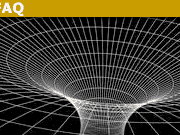Why Is the Speed of Light the Same in All Frames of Reference?
The first thing to worry about here is that when you ask someone for a satisfying answer to a “why” question, you have to define what you think would be satisfying. If you ask Euclid why the Pythagorean theorem is true, he’ll show you a proof based on his five postulates. But it’s also possible to form a logically equivalent system by replacing his parallel postulate with one that asserts the Pythagorean theorem to be true; in this case, we would say that the reason the “parallel theorem” is true is that we can prove it based on the “Pythagorean postulate.”
Einstein’s original 1905 postulates for special relativity went like this:
P1 – “The laws by which the states of physical systems undergo change are not affected, whether these changes of state be referred to the one or the other of two systems of co-ordinates in uniform translatory motion.”
P2 – “Any ray of light moves in the ‘stationary’ system of co-ordinates with the determined velocity c, whether the ray be emitted by a stationary or by a moving body.”
From the modern point of view, relativity is about space and time, not light. We could therefore replace P2 with:
P2* – “There exists a velocity c such that when something has that velocity, all observers agree on it.”
And finally, there are completely different systems of axioms that are logically equivalent to Einstein’s, and that do not take the frame-independence of c as a postulate (Ignatowsky 1911, Rindler 1979, Pal 2003). These systems take the symmetry properties of spacetime as their basic assumptions.
For someone who likes axioms P1+P2, the frame-independence of the speed of light is a postulate, so it can’t be proved. The reason we pick it as a postulate is that it appears to be true based on observations such as the Michelson-Morley experiment (Michelson 1887) or its modern incarnations (e.g., Herrmann 2005). (Einstein knew of the Michelson-Morley experiment when he wrote P2 (van Dongen 2009), but later described himself as having been more influenced by Maxwell’s equations, which imply it as well.)
If we prefer P1+P2* instead, then we actually don’t know whether the speed of light is frame-independent. What we do know is that the empirical upper bound on the mass of the photon is extremely small (Lakes 1998), and we can prove that massless particles must move at the universal velocity c.
In the symmetry-based systems, the existence of a universal velocity c is proved rather than assumed, and the behavior of photons is related empirically to c in the same way as for P1+P2*. We then have a satisfying answer to the “why” question, which is that existence of a universal speed c is a property of spacetime that must hold because spacetime has certain other properties.
W.v.Ignatowsky, Phys. Zeits. 11 (1911) 972
Rindler, Essential Relativity: Special, General, and Cosmological, 1979, p. 51
Palash B. Pal, “Nothing but Relativity,” http://arxiv.org/abs/physics/0302045v1
Michelson and Morley, “On the Relative Motion of the Earth and the Luminiferous Ether,” Am. J. Sci. 34 (1887) 333, http://www.aip.org/history/gap/PDF/michelson.pdf
Herrmann et al., “Test of the isotropy of the speed of light using a continuously rotating optical resonator,” Physical Review Letters 95 (2005) 150401, http://arxiv.org/abs/physics/0508097
J. van Dongen, “On the role of the Michelson-Morley experiment: Einstein in Chicago,” Archive for History of Exact Sciences 63, No. 6, http://arxiv.org/abs/0908.1545
R.S. Lakes, “Experimental limits on the photon mass and cosmic magnetic vector potential”, Physical Review Letters 80 (1998) 1826, http://silver.neep.wisc.edu/~lakes/mu.html
Comments for this FAQ are disabled
PhD in physics. I teach physics at Fullerton College, a community college in Southern California. I enjoy writing, playing viola, brewing beer, climbing and mountaineering.







